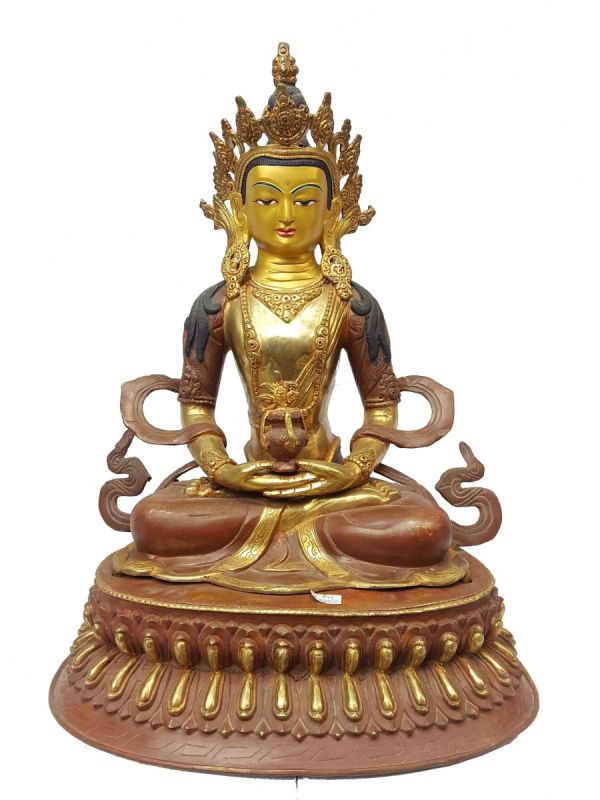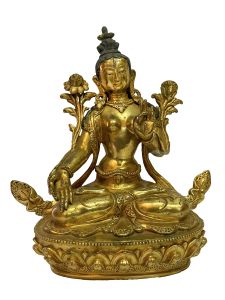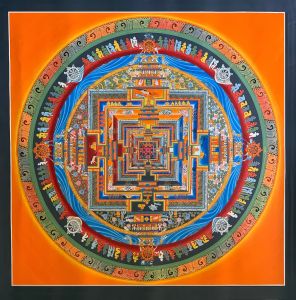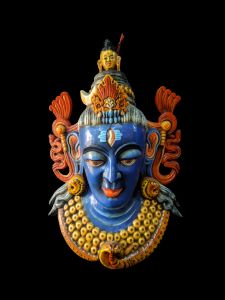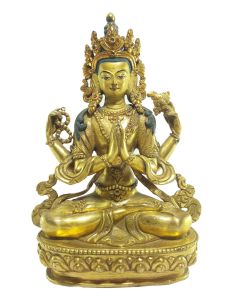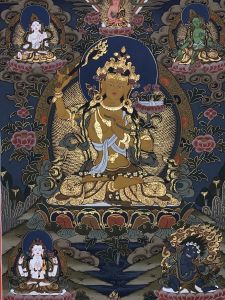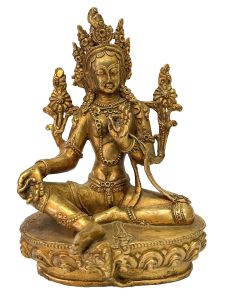MAKING PROCESS: LOSS WAX SYSTEM
The Statue of Amitayus | Aparmita is made by the process of loss wax system, Loss wax system is the oldest process of making the metal sculptures. this is a very long and time-consuming process but the result we get is worth the time and the effort. Nepal is probably the only country still manufacturing the statue by this process. The statue of Avalokiteshvara | Chenrezig above is 100% handmade in Nepal, by the skill full artist from Patan.
FINISHING : PARTLY GOLD PLATED
This is partly fire Gold Gilded statue of Amitayus | Aparmita. The gold is gilded by the ancient process of gold gilding using amalgam Gold. This process of Gold gilding is known as Mercury Gold Gilding (पारा Pārā सुन Suna जलप Jalap), Fire Gilding, or Fire gold plating(In Nepal). Gold gilded by this process is very good for the copper statues, as the statue gilded by this process will retain the gold for very long time. Gold Gilded by this process is comparatively expensive to the modern electrochemical plating but due to it durability it is still a prefered choice for many collectors and practitioners alike. .
Here Gold is applied on the body or the unmasked skin of the Amitayus | Aparmita statue, Golden color representing the skin color of Amitayus | Aparmita statue and and color is painted on the cloth of Amitayus | Aparmita statue representing color of tradition robe worn by Buddhist monks. this is the ideal form of the statue for practitioner as this statues follows all the regulation required by the monastery.
Also this Amitayus | Aparmita statue has gold gilding on the shawl, the lotus flowers and base of the statue. This extra gold plating popularly known as as (Ga cho Lu), which mean Gold on the shawl .
FACE PAINTED
After the Gold plating is completed we will put various foundations of yellow pastes and color to even out the surface of the face then apply a Real Powder gold coat via brush on the statues face. This provides a canvas like surface to draw the eyes and mouth of the statue. This process is traditionally known as eye opening.
FACE: GOLD PAINTED
This Amitayus | Aparmita statue's face has been painted with gold, For a Buddhist practitioner this is a very important feature to have in there idol of worship as before Consecrating the statue it always recommended by Teacher and lamas to have the eyes of the statue opened. Painting face of the statue is also referred Opening Eye in our commonly used language.
LOSS WAX SYSTEM
This is the Nepali handmade statue, Made by the process of los wax system with the skillful hands of Nepali crafts man from Patan a famous city inside Kathmandu valley popular for metal crafts.
FINISHING
This is partly fire Gilded statue. The gold Gilding is done by the ancient process of gold plating, where a grinded mixture of Gold, Mercury and Glass is applied to the body of the statue, which then is heated, burning off the mercury and leaving back a rich permanent plating of gold.
Here he Gold is applied on the body or skin of the statue representing the color of our skin and and cloths are painted in the color of tradition robe of Buddhist monks.


